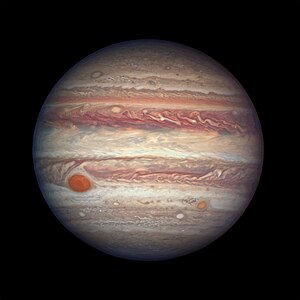 Global Information
Global InformationAtmosphere of Jupiter information

The atmosphere of Jupiter is the largest planetary atmosphere in the Solar System. It is mostly made of molecular hydrogen and helium in roughly solar proportions; other chemical compounds are present only in small amounts and include methane, ammonia, hydrogen sulfide, and water. Although water is thought to reside deep in the atmosphere, its directly measured concentration is very low. The nitrogen, sulfur, and noble gas abundances in Jupiter's atmosphere exceed solar values by a factor of about three.[2]
The atmosphere of Jupiter lacks a clear lower boundary and gradually transitions into the liquid interior of the planet.[3] From lowest to highest, the atmospheric layers are the troposphere, stratosphere, thermosphere and exosphere. Each layer has characteristic temperature gradients.[4] The lowest layer, the troposphere, has a complicated system of clouds and hazes, comprising layers of ammonia, ammonium hydrosulfide and water.[5] The upper ammonia clouds visible at Jupiter's surface are organized in a dozen zonal bands parallel to the equator and are bounded by powerful zonal atmospheric flows (winds) known as jets, exhibiting a phenomenon known as atmospheric super-rotation. The bands alternate in color: the dark bands are called belts, while light ones are called zones. Zones, which are colder than belts, correspond to upwellings, while belts mark descending gas.[6] The zones' lighter color is believed to result from ammonia ice; what gives the belts their darker colors is uncertain.[6] The origins of the banded structure and jets are not well understood, though a "shallow model" and a "deep model" exist.[7]
The Jovian atmosphere shows a wide range of active phenomena, including band instabilities, vortices (cyclones and anticyclones), storms and lightning.[8] The vortices reveal themselves as large red, white or brown spots (ovals). The largest two spots are the Great Red Spot (GRS)[9] and Oval BA,[10] which is also red. These two and most of the other large spots are anticyclonic. Smaller anticyclones tend to be white. Vortices are thought to be relatively shallow structures with depths not exceeding several hundred kilometers. Located in the southern hemisphere, the GRS is the largest known vortex in the Solar System. It could engulf two or three Earths and has existed for at least three hundred years. Oval BA, south of GRS, is a red spot a third the size of GRS that formed in 2000 from the merging of three white ovals.[11]
Jupiter has powerful storms, often accompanied by lightning strikes. The storms are a result of moist convection in the atmosphere connected to the evaporation and condensation of water. They are sites of strong upward motion of the air, which leads to the formation of bright and dense clouds. The storms form mainly in belt regions. The lightning strikes on Jupiter are hundreds of times more powerful than those seen on Earth, and are assumed to be associated with the water clouds.[12] Recent Juno observations suggest Jovian lightning strikes occur above the altitude of water clouds (3-7 bars).[13] A charge separation between falling liquid ammonia-water droplets and water ice particles may generate higher-altitude lightning.[13] Upper-atmospheric lightning has also been observed 260 km above the 1 bar level.[14]
- ^ "Hubble takes close-up portrait of Jupiter". spacetelescope.org. ESO/Hubble Media. 6 April 2017. Retrieved 10 April 2017.
- ^ Atreya Mahaffy Niemann et al. 2003.
- ^ Cite error: The named reference
Guillot1999was invoked but never defined (see the help page). - ^ Cite error: The named reference
Sieff1998was invoked but never defined (see the help page). - ^ Atreya & Wong 2005.
- ^ a b Cite error: The named reference
Ingersoll1was invoked but never defined (see the help page). - ^ Cite error: The named reference
1942Vasavadawas invoked but never defined (see the help page). - ^ Cite error: The named reference
1974Vasavadawas invoked but never defined (see the help page). - ^ Cite error: The named reference
1978bVasavadawas invoked but never defined (see the help page). - ^ Cite error: The named reference
1980Vasavadawas invoked but never defined (see the help page). - ^ Cite error: The named reference
1976Vasavadawas invoked but never defined (see the help page). - ^ Smith, Bradford A.; Soderblom, Laurence A.; Johnson, Torrence V.; Ingersoll, Andrew P.; Collins, Stewart A.; Shoemaker, Eugene M.; Hunt, G. E.; Masursky, Harold; Carr, Michael H. (1979-06-01). "The Jupiter System Through the Eyes of Voyager 1". Science. 204 (4396): 951–972. Bibcode:1979Sci...204..951S. doi:10.1126/science.204.4396.951. ISSN 0036-8075. PMID 17800430. S2CID 33147728.
- ^ a b Becker, Heidi N.; Alexander, James W.; Atreya, Sushil K.; Bolton, Scott J.; Brennan, Martin J.; Brown, Shannon T.; Guillaume, Alexandre; Guillot, Tristan; Ingersoll, Andrew P.; Levin, Steven M.; Lunine, Jonathan I. (5 August 2020). "Small lightning flashes from shallow electrical storms on Jupiter". Nature. 584 (7819): 55–58. Bibcode:2020Natur.584...55B. doi:10.1038/s41586-020-2532-1. ISSN 1476-4687. PMID 32760043. S2CID 220980694. Retrieved 17 January 2021.
- ^ Giles, Rohini S.; Greathouse, Thomas K.; Bonfond, Bertrand; Gladstone, G. Randall; Kammer, Joshua A.; Hue, Vincent; Grodent, Denis C.; Gérard, Jean-Claude; Versteeg, Maarten H.; Wong, Michael H.; Bolton, Scott J. (2020). "Possible Transient Luminous Events Observed in Jupiter's Upper Atmosphere". Journal of Geophysical Research: Planets. 125 (11): e2020JE006659. arXiv:2010.13740. Bibcode:2020JGRE..12506659G. doi:10.1029/2020JE006659. hdl:2268/252816. ISSN 2169-9100. S2CID 225075904.